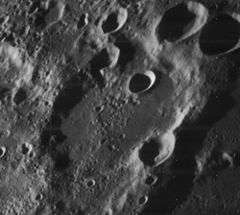Gilbert (lunar crater)
Gilbert is a large lunar impact crater that lies near the eastern limb of the Moon. Due to its location this feature appears foreshortened when viewed from the Earth, limiting the amount of detail that can be observed. The crater lies to the northwest of the similar-sized walled plain Kästner, to the west of the Mare Smythii.
 Oblique Lunar Orbiter 4 image | |
| Coordinates | 3.2°S 76.0°E |
|---|---|
| Diameter | 107 km |
| Depth | Unknown |
| Colongitude | 285° at sunrise |
| Eponym | Grove K. Gilbert William Gilbert |
Several satellite craters in the vicinity have since been given names by the IAU. Nearly attached to the north-northeastern rim of Gilbert are the craters Weierstrass (Gilbert N) and Van Vleck (Gilbert M), two somewhat similar formations. In the northeastern part of Gilbert's interior floor is the small, bowl-shaped Geissler (Gilbert D).
Gilbert is a somewhat degraded walled plain, with an outer rim that has been somewhat reshaped by nearby impacts. The southern rim has almost completely disintegrated, and forms a rolling surface that flows toward the south as an extended depression. The crater pair of Weierstrass and Van Vleck have formed an indented rim along the northeast face, while the northwest rim is overlain by Gilbert S. The interior floor is relatively level with some low ridges running down the center toward the southern end.
Satellite craters
By convention these features are identified on lunar maps by placing the letter on the side of the crater midpoint that is closest to Gilbert.
| Gilbert | Latitude | Longitude | Diameter |
|---|---|---|---|
| J | 4.3° S | 72.7° E | 38 km |
| K | 5.5° S | 73.2° E | 38 km |
| P | 0.9° S | 75.6° E | 18 km |
| S | 1.9° S | 75.6° E | 19 km |
| V | 1.5° S | 79.9° E | 15 km |
| W | 1.1° S | 78.9° E | 19 km |
The following craters have been renamed by the IAU.
- Gilbert D — See Geissler.
- Gilbert M — See Van Vleck.
- Gilbert N — See Weierstrass.
- Gilbert U — See Avery.
References
- Andersson, L. E.; Whitaker, E. A. (1982). NASA Catalogue of Lunar Nomenclature. NASA RP-1097.CS1 maint: ref=harv (link)
- Blue, Jennifer (July 25, 2007). "Gazetteer of Planetary Nomenclature". USGS. Retrieved 2007-08-05.CS1 maint: ref=harv (link)
- Bussey, B.; Spudis, P. (2004). The Clementine Atlas of the Moon. New York: Cambridge University Press. ISBN 978-0-521-81528-4.CS1 maint: ref=harv (link)
- Cocks, Elijah E.; Cocks, Josiah C. (1995). Who's Who on the Moon: A Biographical Dictionary of Lunar Nomenclature. Tudor Publishers. ISBN 978-0-936389-27-1.CS1 maint: ref=harv (link)
- McDowell, Jonathan (July 15, 2007). "Lunar Nomenclature". Jonathan's Space Report. Retrieved 2007-10-24.CS1 maint: ref=harv (link)
- Menzel, D. H.; Minnaert, M.; Levin, B.; Dollfus, A.; Bell, B. (1971). "Report on Lunar Nomenclature by the Working Group of Commission 17 of the IAU". Space Science Reviews. 12 (2): 136–186. Bibcode:1971SSRv...12..136M. doi:10.1007/BF00171763.CS1 maint: ref=harv (link)
- Moore, Patrick (2001). On the Moon. Sterling Publishing Co. ISBN 978-0-304-35469-6.CS1 maint: ref=harv (link)
- Price, Fred W. (1988). The Moon Observer's Handbook. Cambridge University Press. ISBN 978-0-521-33500-3.CS1 maint: ref=harv (link)
- Rükl, Antonín (1990). Atlas of the Moon. Kalmbach Books. ISBN 978-0-913135-17-4.CS1 maint: ref=harv (link)
- Webb, Rev. T. W. (1962). Celestial Objects for Common Telescopes (6th revised ed.). Dover. ISBN 978-0-486-20917-3.CS1 maint: ref=harv (link)
- Whitaker, Ewen A. (1999). Mapping and Naming the Moon. Cambridge University Press. ISBN 978-0-521-62248-6.CS1 maint: ref=harv (link)
- Wlasuk, Peter T. (2000). Observing the Moon. Springer. ISBN 978-1-85233-193-1.CS1 maint: ref=harv (link)
